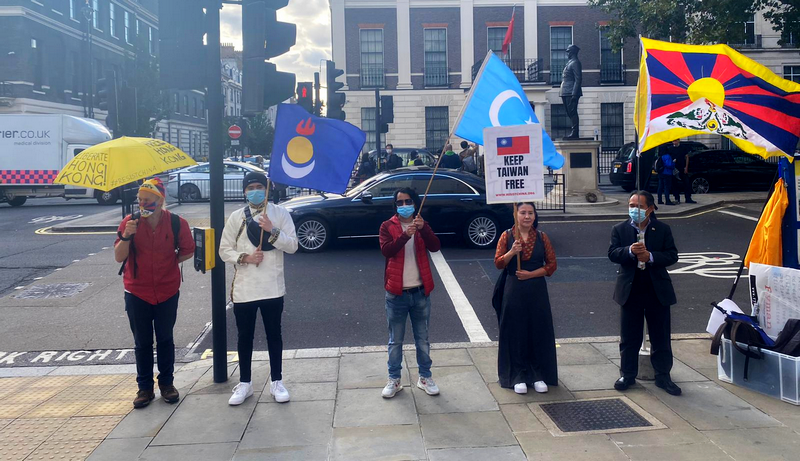London — Activists gathered outside the Chinese Embassy in London to protest against the Chinese Communist Party's (CCP) human rights abuses against Tibetans, Uyghurs, Hong Kongers, and other groups, on October 1, 2020. This protest, which was part of the Global Day of Action against the CCP, was attended by around 100 people. Below are some powerful photos from throughout the day.
Free Tibet activists along with other human rights activists and supporters joined the Global Day of Action to resist CCP abuses. "The events aim to bring activists together to advocate for the rights of Tibetans, Uyghurs, Hong Kongers, Southern Mongolians, Taiwanese, Chinese and other groups who have suffered under the Chinese Communist Party," John Jones, campaigns and advocacy manager, Free Tibet, UK, said in a press release.
While joining the peaceful protest, the Mongolian national flag was held up by two women from Southern Mongolia. Their country was annexed by China after World War II. The Chinese Communist Party (CCP) has since gradually eroded and threatened the culture, language, and independence of the region’s ethnic Mongolian population.
Dawa from the Tibetan community seen holding up a placard. Tibetans chanted ‘China Stole My Land But Not My Voice’ throughout the day. Tibet has been illegally occupied by China since 1950. Any Tibetans in Tibet that are found to be criticising the CCP in any way are likely to be arrested and are at the risk of imprisonment, torture, and, in some cases, even death. Tibetans outside Tibet continue to fight for their country and people.
Members from the Uyghur community, the Tibetan community, and the South Mongolian community again came together to protest. Their respective communities and countries are all being threatened and oppressed by the Chinese government, according to Free Tibet, UK.
Hong Kongers also joined the protest. Hong Kong has witnessed a mass series of on-going protests since March 2019. These anti-government protests were triggered by the introduction of the Fugitive Offenders amendment bill by the Hong Kong government. Citizens were worried that the CCP would continue to undermine Hong Kong’s autonomy.
A Hong Kong protester holds up the iconic yellow umbrella. The yellow umbrella has since become a symbol of resistance in Hong Kong. The symbol emerged from the ‘Umbrella Movement’ -- a political movement that emerged during the Hong Kong democracy protests of 2014. Umbrellas were originally used by protestors as a protective tool against the use of pepper spray by the police. They were continued to be used in the 2019-20 protests.
One group of activists, working autonomously, burned several Chinese flags and displayed one of the burnt flags right at the gates of the Chinese Embassy. They also attached protest messages to the embassy gates. Police soon arrived at the scene but the activists had already fled by that time. Beijing has already demanded a response, citing draconian new laws it has imposed in Hong Kong.
A young girl is seen trying to hand a leaflet to a police officer. The leaflet is about Falun Gong and the organ harvesting of Falun Gong practitioners. Falun Gong is a religious movement that has been targeted and persecuted by the CCP since 1999. There have been reports of the mass execution and organ harvesting of Falun Gong practitioners undertaken by the Chinese government, as part of their antireligious campaign. A group of Falun Gong practitioners also protested on 1 October outside the Chinese Embassy as part of the Global Day of Action.
Protestors holding up the Tibetan flag. The Tibetan flag has become a powerful symbol, not just of Tibetan nationalism, but also of unity and resistance to the CCP, as China has made possessing the Tibetan flag illegal in Tibet. Protestors also hold up an item to represent five communities that are under attack by the CCP.


![Tibet has a rich history as a sovereign nation until the 1950s when it was invaded by China. [Photo: File]](/images/stories/Pics-2024/March/Tibet-Nation-1940s.jpg#joomlaImage://local-images/stories/Pics-2024/March/Tibet-Nation-1940s.jpg?width=1489&height=878)
















